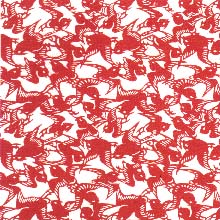Dye (p. 43 )
1. Produced in Morioka City, Iwate Prefecture.
2. Characteristics: Stencil dyeing applied to cotton and pongee with indigo and other plant dyes, such as Shikon and Akane. Long used old patterns are still in use. The stencil was used in the Edo Period for Kosode(kimono) and Kamishimo(set of half garment and skirt) both worn over Kosode as warrior costumes. There are about 300 kinds of patterns, including Komon, all-over patterns, Kasuri, and Nanbu Takewari, family crest of Nanbu clan.
3.Uses: Sashes, interior items.
4. History: The original dyer was Zensuke Hirukoya who lived in Yamanashi Prefecture. He dyed small flags "Sashimono" and warriorユs coats which were worn over the armor "Jinbaori", both of which were used in battle. His family followed the feudal lord in 1633 when the Nanbu clan was ordered to move to Morioka. He named himself the first Somemoto(headmaster of the technique). Mr. Saburo Ono, present dyer, is the 16th master of this dyeing technique. In "Kodai Katazome"(literally, old days stencil dyeing) paper sheets of patterns, paper cutting and dyeing techniques have been inherited from older generations.
Dyeing Method
The Hikizome technique is used mainly with indigo. It is a technique of dyeing cloth using a brush.



